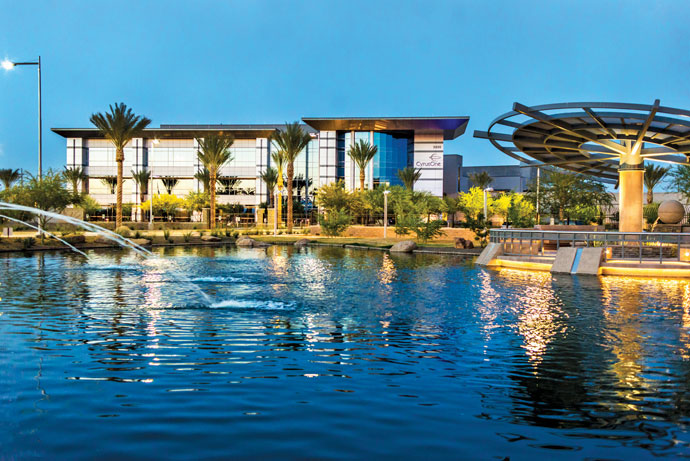The development of a mission-critical data center facility requires extremely thorough and judicious site selection, particularly when providing colocation services.

The biggest challenge for data center providers in choosing a new site is filtering through the vast number and variety of sites available. This is why CyrusOne’s site-selection model takes into account more than 60 elements for consideration. And while each of these factors demands attention, the following 10 items are among the most critical to consider.
- Utility Availability and Consumption Costs: While today’s data centers are more energy efficient than ever before, running a mission-critical infrastructure calls for a considerable amount of energy. Selecting a data center site requires not only affordable and predictable utility rates but also the capacity to meet long-term demands. Special consideration also needs to be given to the availability and pricing of water and sewerage.
- Climate/Natural Disasters: When selecting a geographic location for a data center facility, companies often evaluate the probability for natural disasters or other obstructive acts of regional climate. Equally important are the environmental impacts of a given location, such as average temperature and humidity, as these have a direct impact on operating costs for the lifetime of your facility.
- Tax Regimes: Local and state tax policies can have a dynamic impact on a data center’s ongoing operating costs. Due to the capital-intensive nature of data centers, property taxes can either inhibit or encourage real estate improvements and investment in equipment. The tax apportionment structure of corporate income tax rates is another consideration with material impact. In this case, many data center companies seek states with single-sales-factor apportionment. Specifically, sales taxes are critical to the establishment and ongoing development of data centers. States with minimal or average sales tax rates that do not apply to a variety of purchase types are highly desirable.
- Construction and Labor Considerations: The cost, quality, and availability of labor have a material influence on data centers and their operating costs. It is important to select a geography that is known for an educated and cost-effective labor force. This applies to initial and ongoing construction projects as well as the day-to-day maintenance and labor involved in the upkeep and security of a data center facility. Identifying this type of skilled personnel is crucial to upholding standards for customer service and ensuring long-term business growth.
- Connectivity to Telecommunications Framework: The nature and purpose of a data center is deeply tied to telecommunications and requires a redundant infrastructure through the convenience of multiple connection points. A data center’s proximity to vital telecom “trunk” lines and national carriers is crucial to the performance and successful operation of a data center.
- Amenities for Employee/Customer Satisfaction: Similar to many industries, it is also important to consider the quality of life in a prospective market. A data center location must have easy ways into and out of the facility. In addition to major roads and highways, the location should be within reasonable driving proximity to an airport, housing, and entertainment amenities. These factors help maintain a positive workforce with low turnover, which is an important element of running a successful data center and ensuring customer satisfaction.
- Business Expansion Incentives: Data center designs are intended for growth and expansion far beyond the initial construction. That means sites that benefit from local and state incentives for economic development are opportune for data center providers. These incentives enable companies to reduce the cost of individual development projects and, in turn, the ongoing operating costs of the business.
- Customer Demand: Demand and growth potential are essential drivers in any expansion decision. It is essential that a data center be located within close proximity to both current and potential customers as well as where they plan to do business.
- Proximity to Customers/Prospects: Selecting a site that is in close proximity to a high concentration of prospective companies is ideal.
- Operating Risk: In a post-Snowden operating environment, more and more customers have definitive opinions as to where they’d like their data to reside. This is also having an impact on the way customers design their infrastructure to ensure that data is properly classified, migrated, and stored in proper geographies according to governmental and political policies.
The requirements for every data center facility can vary, which means that different elements carry various weights depending on the project at hand. However, these 10 key elements maintain a dynamic impact on all data center site selections.
At CyrusOne, the selection of a new site is only the initial stage of developing a mission-critical data center. The company has established 27 carrier-neutral data center facilities across the Unites States, Europe, and Asia. Facilities are engineered to include the power-density infrastructure required to deliver excellent availability, including an architecture with the highest available power redundancy (2N). Across these sites, CyrusOne uses Massively Modular® engineering to deploy capital efficiently.

CyrusOne’s scalable and flexible solutions, including its National Internet Exchange (IX) platform, provide enterprise businesses with money-saving efficiencies to improve their bottom line, and the capability to grow their mission-critical IT infrastructure at a natural, manageable rate. This approach to data center site selection, expansion, and customer service has earned the business and respect of nine of the Fortune 20 and 146 of the Fortune 1000 companies.
Through a growing global network of 27 data centers — including its newest facility in the Northern Virginia city of Sterling in Loudoun County, opened in May 2015, and the recently purchased Austin III site in Texas — CyrusOne provides mission-critical data center facilities that protect and ensure the continued operation of IT infrastructure for more than 675 customers. As chief technology officer of CyrusOne, Kevin Timmons is responsible for defining and socializing the technology roadmap for CyrusOne’s 27 data centers. He also oversees site selection, design, and construction of the company’s worldwide data center assets.
